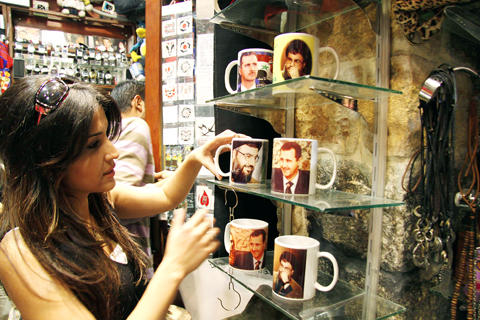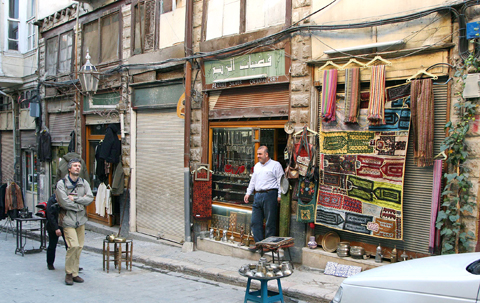Iranian pilgrims pray beside Arabs at the 8th-century Umayyad Mosque, one of Islam’s grandest sites. Down a nearby alley, European tourists watch restoration work at an Ottoman-era palace being converted into a hotel.
“I’ve not seen such contrast between image and the reality,” German tourist Anna Kopola said, looking at Syrian art on display in a gallery in the capital, Damascus. “Syria is portrayed as a center of terrorism in the West, but it’s peaceful and modern.”
While tourists have long traveled to see Egypt’s pyramids, tense ties with the West made Syria a no-go zone for decades.

PHOTO: AP
Few have heard of the magnificent ruins at Dura Europos, a Graeco-Roman city dubbed the Pompeii of the desert, or Krak des Chevaliers, among the world’s greatest Crusader castles.
But a rapprochement with the West — Syria this month invited US President Barack Obama to Damascus for talks — and the gradual liberalization of an economy that long shunned foreign input are helping Syria shed its pariah state image.
“Nicolas Sarkozy’s visit last year was a boost,” Antoine Mamarbachi, a tour operator said of the French president.

PHOTO: REUTERS
“Syria is no longer a persona non grata,” he said.
Tourist numbers rose 15 percent last year and Syrian Tourism Minister Saadallah Agha al-Qalaa expects 40,000 new hotel beds to become available in the next three years, up from 48,000 now.
Demand has grown so fast, he said, that Syrian tourism may escape the impact of the global downturn that has hit the sector worldwide. Tourism already accounts for 13 percent of Syria’s gross domestic product and will only become more important as the Arab country’s dwindling oil production falls further.
Syria has so far tended to attract visitors from other parts of the Middle East, who are less perturbed by its image and more interested in its beach resorts. Two-thirds of visitors last year were Arab, but promotional campaigns by the state and tour operators over the last year have targeted high-end Europeans.
As the East-West crossroads of the ancient world, Syria has been a trade hub for centuries, attracting European adventurers from Lawrence of Arabia to Freya Stark.
Dura Europos, the ruined walled city above the banks of the Euphrates, produced early examples of Judaic and Christian art. The Umayyad Dynasty made Damascus the capital of a Muslim empire that stretched to Spain.
Legend has it that two heads are buried beneath the Ummayad Mosque — those of John the Baptist and Imam Hussein, an early Islamic figure whose killing in 680 cemented Shiite-Sunni splits.
But Syria’s modern history has been dominated by its struggle with Israel and Soviet-style policies since the Baath Party’s 1963 coup that reduced it to an economic backwater.
The US imposed sanctions on Syria in 2004 and the government faces two UN investigations, although tensions have eased in recent months and Washington said last month it would appoint an ambassador to Damascus after a four-year hiatus.
“The business environment in Syria is still poorer than its neighbors, but this is a virgin market and the fact that so many investors are coming shows that the risk is worth taking,” said Jihad Yazigi, editor of the Syria Report online newsletter.
Only in the past decade has Syria eased restrictions on foreign exchange and banking and allowed companies to transfer profits abroad. But it remains among the world’s hardest places to do business, a World Economic Forum study said.
Courts lack safeguards against political interference and the workforce lacks language skills and training. Yet the risks have not put off investors from the oil-exporting Gulf.
Qatari Diyar, a real estate company owned by the Qatar Investment Authority, is building a US$350 million resort on the Mediterranean coast. Kuwait’s Kharafi group is building a 361-room hotel in Damascus. Global hotel brands — including Movenpick, Kempinski and Holiday Inn — also plan developments.
“Syria is a bargain, although it needs to develop its infrastructure,” Kuwaiti businessman Abdul Hameed Dashti said.
In the covered souqs of Old Damascus, Western tourists now shop for Syrian kilims and amble from the tomb of the Mamluk ruler Baibars to courtyard houses-turned-boutique hotels.
Gone are the days when a visitor could wander through the ruins of Palmyra, a classical city that rises like a mirage from the eastern desert, without encountering another soul.
“Syria needs to do more preservation. I was in Lebanon and the level of indiscriminate construction made me never want to go back,” Swiss tourist Roland Diethelm said.
Repeated wars have left scars on Syria’s neighbor Lebanon, but those tourists who do make the journey often combine it with a short drive to Damascus.
Construction across Syria has been chaotic but investors are taking increasing care to preserve the character of Old Damascus and Aleppo, realizing that this is what many Europeans crave.
Opened a year ago, Beit Zaman hotel is a painstakingly restored 300-year-old courtyard house located on Damascus’ Roman-era Straight Street, which is mentioned in the Bible.
“Our customers appreciate the restoration work we have done and the feel of Old Damascus,” Beit Zaman spokeswoman Solar Arissian said.

Authorities have detained three former Taiwan Semiconductor Manufacturing Co (TMSC, 台積電) employees on suspicion of compromising classified technology used in making 2-nanometer chips, the Taiwan High Prosecutors’ Office said yesterday. Prosecutors are holding a former TSMC engineer surnamed Chen (陳) and two recently sacked TSMC engineers, including one person surnamed Wu (吳) in detention with restricted communication, following an investigation launched on July 25, a statement said. The announcement came a day after Nikkei Asia reported on the technology theft in an exclusive story, saying TSMC had fired two workers for contravening data rules on advanced chipmaking technology. Two-nanometer wafers are the most

NEW GEAR: On top of the new Tien Kung IV air defense missiles, the military is expected to place orders for a new combat vehicle next year for delivery in 2028 Mass production of Tien Kung IV (Sky Bow IV) missiles is expected to start next year, with plans to order 122 pods, the Ministry of National Defense’s (MND) latest list of regulated military material showed. The document said that the armed forces would obtain 46 pods of the air defense missiles next year and 76 pods the year after that. The Tien Kung IV is designed to intercept cruise missiles and ballistic missiles to an altitude of 70km, compared with the 60km maximum altitude achieved by the Missile Segment Enhancement variant of PAC-3 systems. A defense source said yesterday that the number of

A bipartisan group of US representatives have introduced a draft US-Taiwan Defense Innovation Partnership bill, aimed at accelerating defense technology collaboration between Taiwan and the US in response to ongoing aggression by the Chinese Communist Party (CCP). The bill was introduced by US representatives Zach Nunn and Jill Tokuda, with US House Select Committee on the Chinese Communist Party Chairman John Moolenaar and US Representative Ashley Hinson joining as original cosponsors, a news release issued by Tokuda’s office on Thursday said. The draft bill “directs the US Department of Defense to work directly with Taiwan’s Ministry of National Defense through their respective

Tsunami waves were possible in three areas of Kamchatka in Russia’s Far East, the Russian Ministry for Emergency Services said yesterday after a magnitude 7.0 earthquake hit the nearby Kuril Islands. “The expected wave heights are low, but you must still move away from the shore,” the ministry said on the Telegram messaging app, after the latest seismic activity in the area. However, the Pacific Tsunami Warning System in Hawaii said there was no tsunami warning after the quake. The Russian tsunami alert was later canceled. Overnight, the Krasheninnikov volcano in Kamchatka erupted for the first time in 600 years, Russia’s RIA